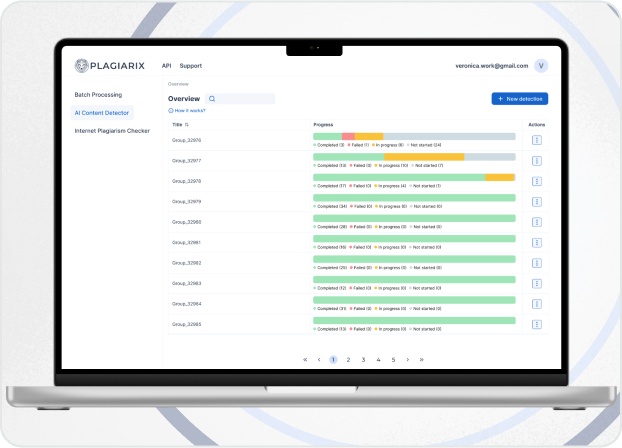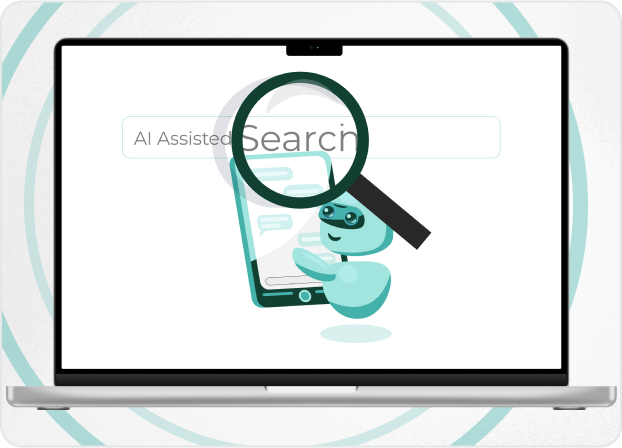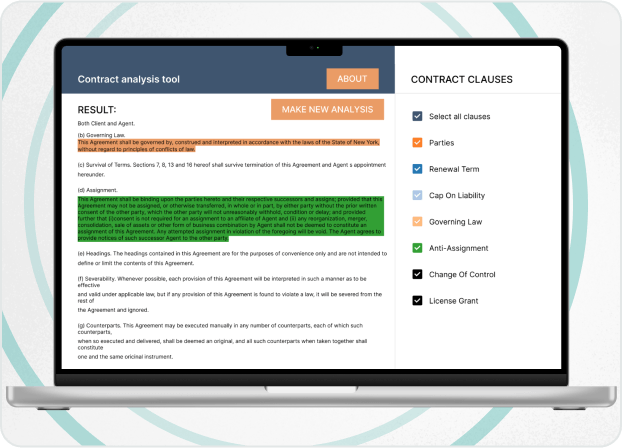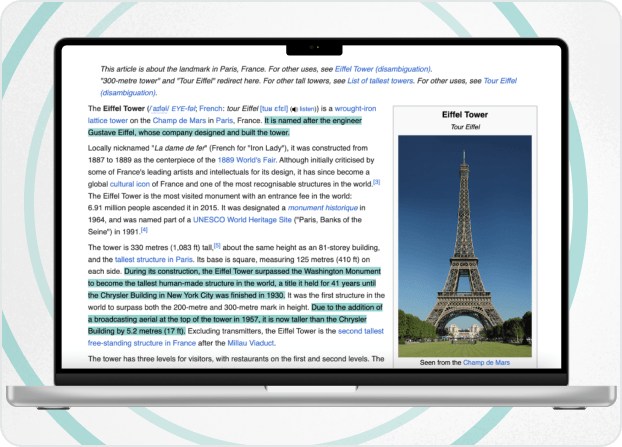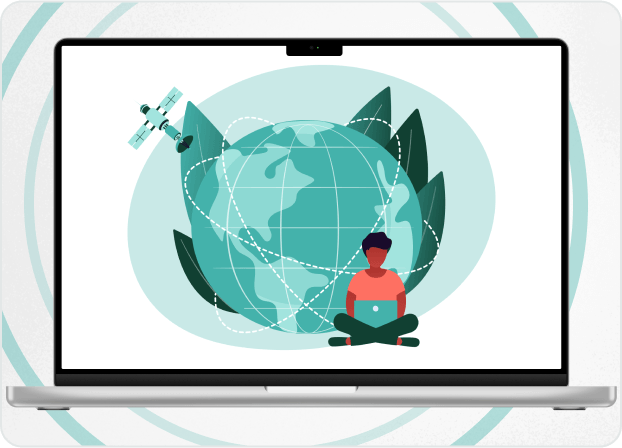
Expert’s Thoughts

"AI has become one of the fastest-growing technological industries in history, having almost the same significance as the Internet and mobile phones had decades before. Through that, more and more organizations are eager to implement AI in any way, while the number of AI companies grows every year.
s The following blogpost provides a comprehensive overview on both the biggest AI companies and relatively new players in the AI development market. Additionally, we will focus on key factors which businesses should consider while choosing a partner or a vendor for AI solutions development and implementation."
Karina Antukh — Business Solutions Advisor
Market Insights
Since Open AI released its advanced ChatGPT chatbot, the term ‘artificial intelligence’ has been on everyone’s lips, and the industry has got through an unbelievable increase. These are only a few facts regarding its current condition.
The AI development market size reached 300 billion USD in the first quarter of 2025 with an annual growth rate of 32%. It means that in less than five years the market size will pass the frontier of 1 trillion USD (Business Research Company).
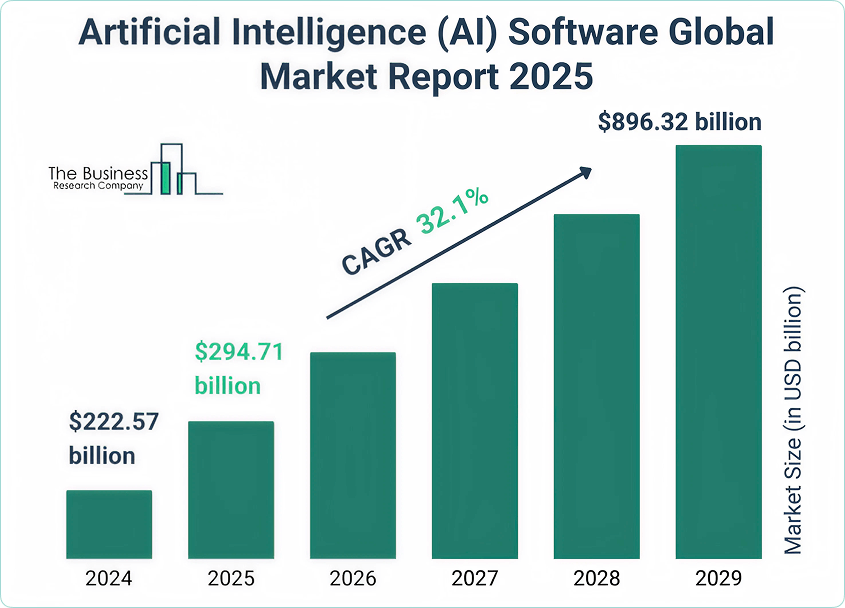
North America is a leader in the AI development industry, sharing almost 30% of the global market ( Grand View Research ).
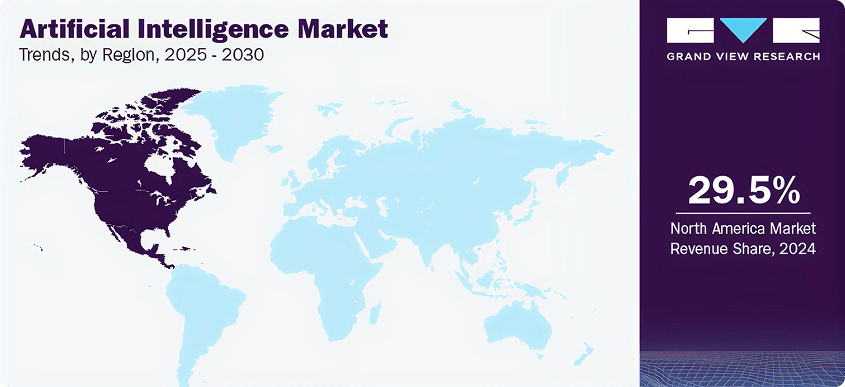
Source: Grand View Research
- At the end of 2024 around 80% of world organizations reported using AI in their products, services and internal operations (Artificial Intelligence Index report of 2025).
- From 39 to 83% of people from the United States, Canada, China, Indonesia, Thailand, Germany, the Netherlands, the United Kingdom and France see AI products and services as beneficial both for business and everyday life ( Artificial Intelligence Index report of 2025 ) .
Therefore, companies all around the world see great perspectives in using AI for marketing or operational needs, but far from all of them can afford AI capabilities implementation or full AI tool development.
In this blogpost we’ll cover two main questions. First, we’ll have a look at the most successful and prominent players of the AI development market, both large and small, and see what they can offer in terms of business collaboration.
Second, we’ll discover several factors, mandatory for consideration in order tochoose the right AI solution developer.
Top Artificial Intelligence Companies of 2025
First, let’s focus on top companies in the AI development market, those who define the industry and demonstrate the most outstanding results.

Open AI
Founded in 2015 as a non-profit research laboratory, OpenAI has quickly turned into the most influential AI software development company. By 2025, the company's GPT large language models have reached their fourth generation (ChatGPT-4.5) and Open AI plans to release the fifth (ChatGPT-5) by the end of the year .
The new chatbot model will achieve near-human contextual understanding across text, voice and visual modalities. However, ChatGPT is not the only product the company owns.
For example, DALL-E, an innovative tool natively built on ChatGPT that created images from the textual prompts that users enter into the chatbot. Here we can add Whisper (an automatic speech recognition model that can transcribe specific speech into text, no matter the accent or dialect) and Codex (a cloud-based AI agent specially developed for performing software engineering tasks).
Furthermore, OpenAI is actively expanding, building strategic partnerships and attracting new investments. The most famous and large step made within this policy is Open AI’ collaboration with Microsoft. It started in 2019, when Microsoft invested 10 billion USD into Open AI technologies, and expanded when it has embedded OpenAI's models API throughout their Azure cloud ecosystem. The main goal of such a partnership is to challenge Google and its absolute dominance in the field of searching systems.
Additionally, such financial giants like Thrive, Founders Fund, Sequoia Capital, Andreessen Horowitz, and K2 Global have invested more than 300 billion USD into Open AI projects, supporting the company’s efforts to advance AI industry.
However, the company struggles with several critical weaknesses. First, the "black box" nature of their most advanced models has drawn criticism from regulators and leads to lot of problems regarding Open AI’s tools implementation, Though the company promises to change the situation with the new ChatGPT-5 model version.
Second, Open AI already has several competitors with less resources but same capabilities. The most prominent example of this year is DeepSeek who created a chatbot bearing 90% of ChatGPT’s functionality but had cost dozens of times less.

Meta AI
The second member of our list is Meta AI – a division of Meta Platforms corporation, specially founded almost 10 years ago for artificial intelligence and augmented reality technologies development.
Meta's open-source Llama 4 language model released in April 2025 is considered as one of the most outstanding competitors of Open AI’s ChatGPT. Meta itself declares that their product demonstrates the best performance at the lowest cost on the LLM market.
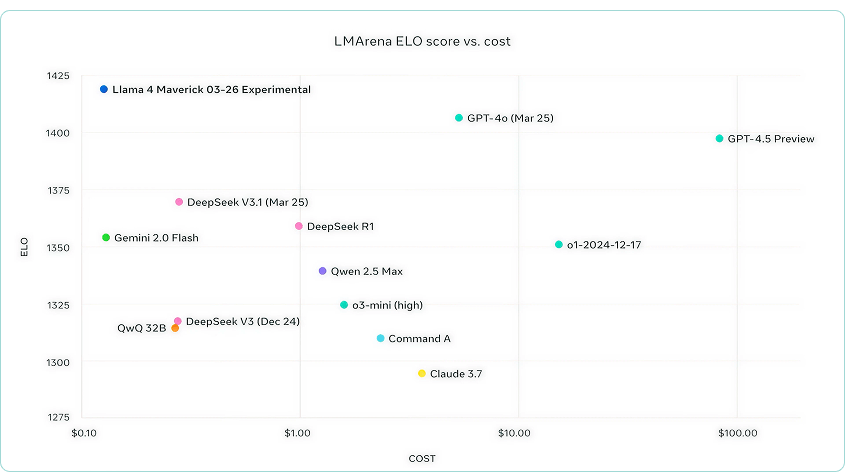
Assumptions:
- Cost estimates assume distributed inference with speculative decoding, fp8 quantization, and persistent caching, as well as a disaster recovery buffer and a $2/hr H100 operating cost.
- To deliver a user experience with a decode latency of 30ms for each token after a one-time 350ms prefill latency, we estimate that the model can be served within a range of 30.9 to 30.49 por million tokens (5:1 blend).
- LMArena testing was conducted using Llama 4 Maverick optimized for conversationality.
Source: www.llama.com
Furthermore, at the end of 2024 Meta established a new group of AI tools tailored for business needs. An example of such a tool is Meta's new business AI chatbot, which can be implemented into companies’ custom AI chatbots to talk to their clients and facilitate transactions in WhatsApp and Messenger. Many specialists consider it as a right step from the Meta point of view, as of 335 million companies and organizations existing in the world, almost 200 million use Meta products in their operations.
However, Meta still faces some problems. For example, the European Union has charged the company for 200 million euro , as it forced Facebook and Instagram users to choose between seeing personalized ads or paying to avoid them.
In addition, Meta’s emotion recognition technology, while technically impressive, has been banned in 12 countries due to privacy violations. Internally, the company struggles with talent retention as top researchers flee to smaller AI startups. The reason for that is Meta’s increasing focus on advertising optimization over groundbreaking research, which is considered unacceptable by some of the specialists.

Anthropic
The next artificial intelligence company is Anthropic, whose Constitutional AI method of 2023 has become the gold standard for responsible and ethical AI development by 2025. Though being a rather young company, Anthropic was one of the first who formulated the rules of building harmless artificial intelligence tools, having developed 17 of the 23 international standards for AI alignment. The company maintains its principled stance against military applications, turning down lucrative defense contracts to focus on social good applications.
At the same time, their Claude assistant, and its latest version Claude 3.7, serves as one of the most prominent LLM tool that helps in performing various tasks from text writing to coding and advanced data analytics.

Google AI
One more giant of the AI software development companies' industry is Google AI, a division of Google founded in 2017, as a main performer in company's AI-related activities. Google's AI efforts in 2025 represent the most comprehensive integration of artificial intelligence into consumer and enterprise products.
Except its Gemini large language model, which is still considered as one of the most dangerous competitors of ChatGPT, Google also presents enough AI products and extensions that can be easily integrated in both internal business processes and in everyday life. Here are just a few of them:
- Flow. An AI-based filmmaking tool developed and fine-tuned for making cinematic clips, scenes and cohesive narratives with intuitive prompting.
- NotebookLM. A special tool made for assistance in work, studying and teaching.
- AI Mode. A special extension for Google Search that provides the user with AI responses before showing the websites lists.
Additionally, Google AI provides a vast list of AI features that can be implemented across Google-based services (Google Workspace, Google Search, Google Maps, etc.) along with new tools (like Whisk or Project Mariner).
However, the company faces antitrust investigations regarding alleged monopolistic practices in AI training data acquisition. Furthermore, Google's "AI-first" strategy has alienated core search users, with 28% reporting they can't distinguish organic results from AI-generated content.

Microsoft
We go further to Microsoft, whose contribution to the AI industry can’t be overestimated. The company’s AI strategy focuses on leveraging artificial intelligence for business applications and use cases.
According to the words of company’s CEO Satya Nadella said on January 2025 , “Microsoft has added more data center capacity last year (2024) than any other year in the company’s history”.
Their Microsoft Fabric, an analytics platform that provides advanced end-to-end data analytics. The tool focuses on unifying the data analytics operations on every stage (from data preparation to final analysis) with the main purpose to create a united working surrounding for business specialists collaborating within single data projects. Fabric integrates AI capabilities throughout its stack, enhancing productivity and insights withtools like Copilot for Notebooks, Copilot for Power BI .
Furthermore, Microsoft’s partnership with OpenAI has evolved into a full integration. As Satya Nadella said, "the number of Azure OpenAI apps running on Azure databases and Azure App Services more than doubled year-over-year."
One more prominent example of such a partnership is that Microsoft integrated OpenAI’s GPT-4 into its Bing search engine and Microsoft Edge browser and branded it as Bing AI. The main goal of such a collaboration is to compete with Google and challenge its long-term dominance in the search systems industry.

IBM Watson
Among all the companies considered on our list, IBM is the oldest and one of the most respected with a half-century history of successful operationing in the technological market.
Unlike many other large AI companies, IBM doesn’t share the initiative of creating AI tools for sake of AI tools. The vast expertise dictates that only those solutions are worthy of attention which can attract investments. That’s why IBM policy and strategy of its WatsonX is to build and promote solutions for real business use cases . It’s not about primitive automated CV screening or customer support chatbots – it's about strategic operations like sales targeting, transport and manufacturing efficiency or strategic analytics.
Through that, IBM’s Wotson is still highly trusted by financial organizations, healthcare providers and even government institutions.
However, IBM is permanently challenged by relatively new companies that have grown from startups (like OpenAI, Anthropic, DeepSeek and others). They are much more flexible, and they understand how versatile business needs can be, and they know that automated CV screening and usage of chatbots in customer support is no less vital than strategic decision-making.

Palantir
Next company is Palantir Technologies, founded in 2003 as a software developer for big data operations. By 2025 Palantir has become one of the main technological providers for national security organization in the United States and NATO countries. Their AIP (Artificial Intelligence Platform) now processes over 90% of classified intelligence data for NATO countries, while their commercial Apollo system predicts supply chain disruptions with 99.7% accuracy. The company's controversial but effective predictive policing algorithms are deployed in 37 major cities worldwide, despite ongoing civil liberties debates.
The company has also emerged as the leading provider of AI systems for space exploration, with contracts from NASA and private aerospace firms. Their Gotham platform remains the standard for intelligence analysis, now enhanced with generative AI capabilities for scenario forecasting.
Nevertheless, these strengths come with mounting weaknesses. Palantir is one of the private companies that cause large concern from the point of human rights organizations.
The European Parliament report of May 2024 named ‘ Artificial intelligence (AI) and human rights: Using AI as a weapon of repression and its impact on human rights ’ refers to Palantir Technologies as to one of the US-based companies that ‘concerns surrounding civil liberties, privacy infringements and potential misuse persist’ . In addition to that, Palantir’s successful business activities directly depend on government contracts, which means that the company still has a rather narrow direction of its technologies development.

Cohere
The next company of our overview is not so large or well-known. Cohere was founded in 2019 in Canada and for a rather short period of time has carved out a dominant position in enterprise language AI market.
Cohere’s focus is to ‘bring cutting-edge multilingual models, advanced retrieval and an AI workspace tailored for the modern enterprise’.
Their Command models family specializes in industry-specific knowledge, with tailored versions for legal, financial and technical documentation that outperform general-purpose models in accuracy tests. In addition, the company obtains a bunch of private generative and advanced retrieval models along with full workplace systems:
- Aya Expanse. An open-science initiative project based on collaboration of specialists from all over the world to develop state-of-the-art models and datasets that expand the number of human languages covered by AI tools.
- Embed. A multimodal representation model that can transform texts and images into numerical entities (vectors) that can be used in the semantic search RAG and advanced classification operations.
- Rerank. A special service developed for search improvement, as it focuses on semantic relevance more than on primitive keywords positioning and matching.
North. An enterprise digital workspace used for processes automation and decision-making optimization. It achieves that through a variety of functions, including AI agents' creation and AI-based content generation.
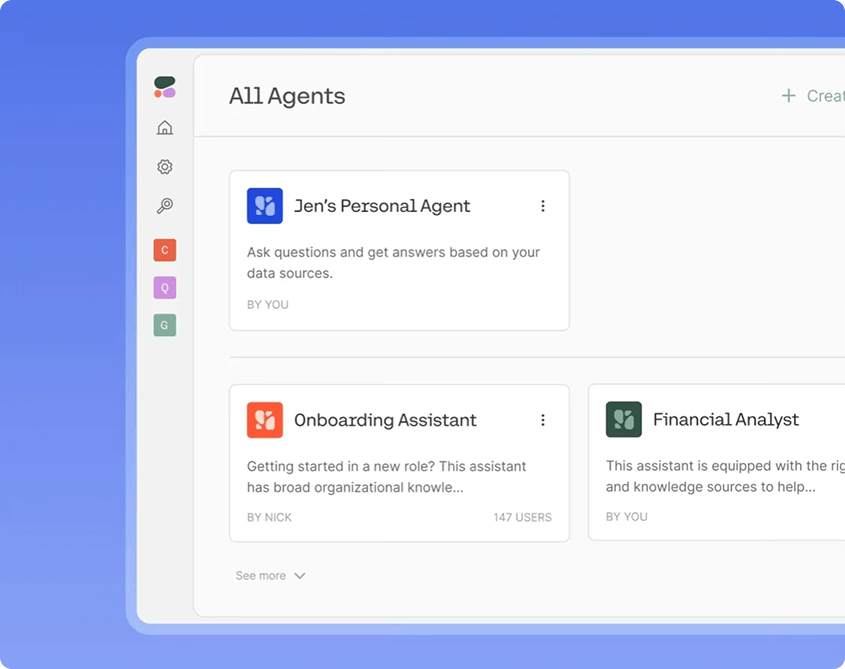
Source: https://cohere.com/north
Compass. An end-to-end search system to surface contextually relevant information from across business, which can also connect all corporate data sources within a single search window.
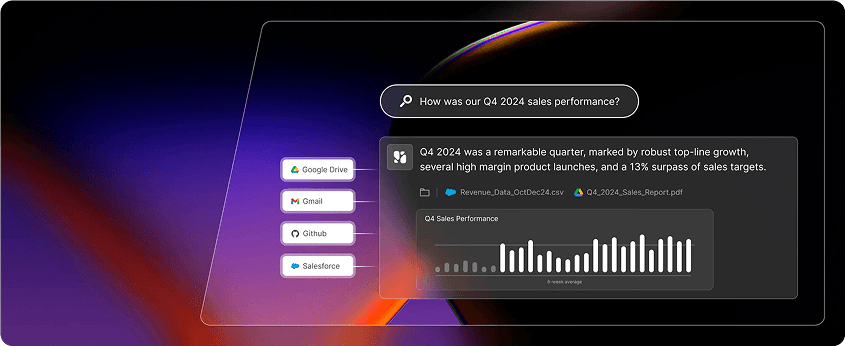
Source: https://cohere.com/compass
However, enterprises all around the world question whether to invest in Cohere’s specialized tools or stop at "good enough" alternatives from larger providers like OpenAI and Anthropic, who provide enterprise access to their AI models APIs.

Runaway AI
Runway is an ai software company founded in 2018 which is most notable for developing commercial text-to-video and video generative AI models called Gen. Here is the information the company representatives provided to TechCrunch on March 31, 2025.
‘Gen-4 can utilize visual references, combined with instructions, to create new images and videos utilizing consistent styles, subjects, locations and more, all without the need for fine-tuning or additional training’ .
Their Gen-4 video synthesis platform can create high-quality scenes from text prompts, while maintaining unprecedented control over cinematography and continuity. The company's recent "Infinite Assets" technology generates never-repeating textures and 3D models for game development.
Yet Runway operates in the industry's most legally fraught space. Ongoing lawsuits from artists and studios threaten core training data practices. The company's valuation has fluctuated wildly as investors struggle to assess liability risks. Most critically, Runway's technology makes it increasingly difficult to distinguish between human and AI creativity - a philosophical crisis that could undermine their entire value proposition.

Silk Data
Silk Data is an artificial intelligence company that specializes in a vast range of AI and IT services.
Our services include:
- Artificial intelligence development;
- AI and IT consulting;
- Web development (both classic and AI-based);
- Mobile development (both classic and AI-based);
- Data Science and Advanced Analytics solutions development .
Unlike most of the tech giants and startups from the above-mentioned list, Silk Data is free from development bureaucracy and famous for its smooth and quick development of various AI and IT solutions.
Various teams of web and mobile developers, ML engineers, QA specialists and marketing experts provide large expertise on all stages of IT projects from the requirements analysis phase to further deployment and ongoing maintenance.
Our solutions and tools ensured improved productivity and advanced processes automation among smaller and larger companies from industries of Marketing, Education, Retail, Recruiting, Ecology, Agriculture and Finances.
Additionally, Silk Data released its own product named Plagiarix which is about to say a new word in the industry of AI and plagiarism detection.
Key Factors and Criteria of Choosing AI Development Company

Business goals
First, you should clearly define what tasks your AI solution should solve and what the technical requirements of such a solution are.
For example, you’d like to have your own NLP-based chatbot, an analogue of ChatGPT and DeepSeek. Perhaps, you need an advanced AI agent or full AI avatar that will bring the sense of human presence into your app or website. You may also require a primitive solution for repetitive tasks automation or focus on advanced AI-based predictive analysis.
All these projects require different levels of expertise and different amount of resources.
Obviously simple solutions are not a task for technological giants with hundreds and thousands of specialists. At the same time, building a chatbot identical to ChatGPT is a task that requires large experience and vast resources, which are unavailable for small companies. An important consideration is that projects of such a scale are not quick and can take many months of intensive work.

Expertise and talent pool
The second factor that should be considered while choosing the right AI development vendor refers to their experience on the market along with the expertise of specialists they work with.
The principle is simple: if you need sophisticated large-scale solutions, you need experienced developers. At the same time, if your request is not so complicated, you may ask for a less experienced and smaller team with a lower cost of development.
There’re also several models of applying for ‘outside’ development that were thoroughly discovered in one of our previous blogposts. Silk Data offers a perfect combination of reasonable prices and comprehensive development and consulting experience.

Market reputation
In addition to the company’s expertise, you should look at its history. There are lots of companies who may present an exciting covering, hiding some dark spots of their activity.
The best way of finding out whether your potential vendor is a reliable and responsible partner or not, is to search through the open sources and close Internet communities. You should look for information regarding the company’s successful projects, read through reviews of both partners and clients and even interact with the product developed by your possible vendor (if available).
If you see lots of good reviews and use experiences from trustworthy people and organizations, if you can’t find any news and sources about problems with ethical or legal issues, the company should be thoroughly considered as your AI supplier.

The range of services and solutions
The number of services and possible solutions is a direct indication of the company’s expertise and level of access to professional specialists.
It also indicates whether the company could help you with your project or not, as the narrow services range implies that the solution outside this range may take much more time and lead to unwilling delays and maintenance problems.
Additionally, if the company provides a detailed description for each service or solution on their website, it’s better to review them, as they can be identical to your task.

Pricing policy
When it comes to the pricing issue, it’s not about finding the lower price for an equal amount of work, it’s also about a clear and transparent pricing policy.
It describes the situation when the potential vendor can explain the sum they charge and highlight the amount of work and number of operations included.
For you as for potential clients, it’s always better to know what exactly you pay for.

Post-development support
The final criterion of the right choice is to find out about the company’s capabilities of further maintenance of the development solution.
You may require systematic monitoring of AI system’s performance or need regular updates.
Conclusion
The AI industry in 2025 is a dynamic and rapidly evolving space, dominated by both established tech giants and innovative newcomers. Companies like OpenAI, Meta AI, and Google continue to push the boundaries of artificial intelligence, while firms like Anthropic and Cohere carve out niches in ethical and enterprise-focused AI.
However, no company is without its challenges. Regulatory scrutiny, ethical dilemmas, talent retention, and competition from open-source alternatives pose significant risks even for industry leaders. Businesses looking to adopt AI solutions must carefully evaluate their needs and choose a partnerthat aligns with their strategic goals.
Key factors such as expertise, market reputation, pricing transparency, and post-development support should guide your decision-making. While tech giants offer robust and scalable solutions, smaller firms like Silk Data provide agility and tailored services that may better suit niche requirements.
In our opinion, the future belongs to companies that can harness AI’s potential while navigating its complexities. Anyway, the right partnership will be crucial in that journey.
Our Solutions
We work in various directions, providing a vast range of IT and AI services. Moreover, working on any task, we’re able to provide you with products of different complexity and elaboration, including proof of concept, minimum viable product, or full product development.


















